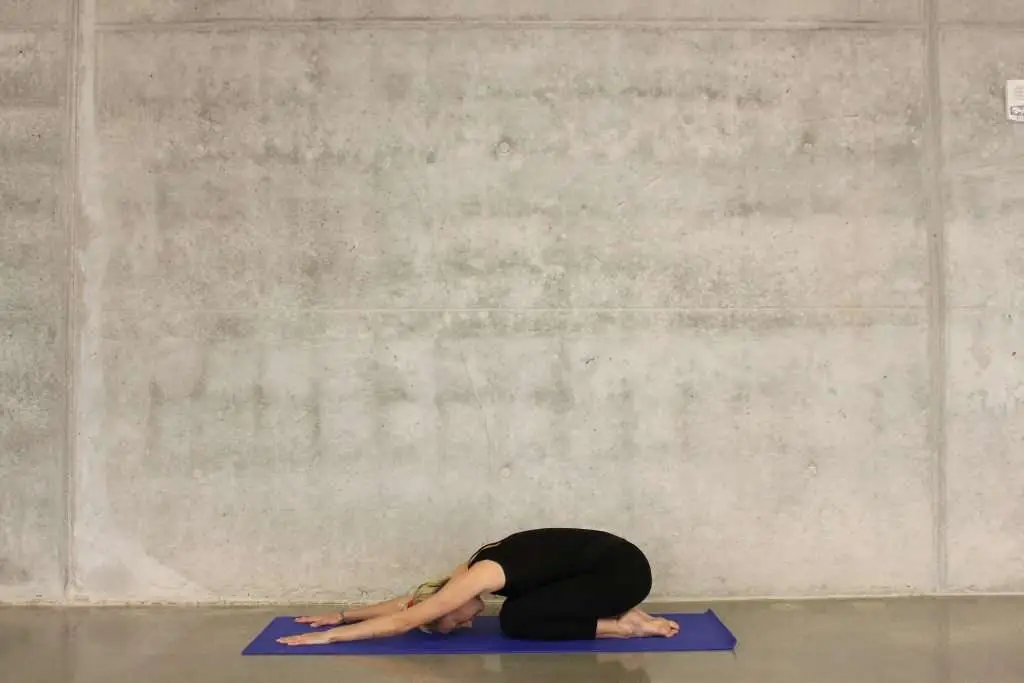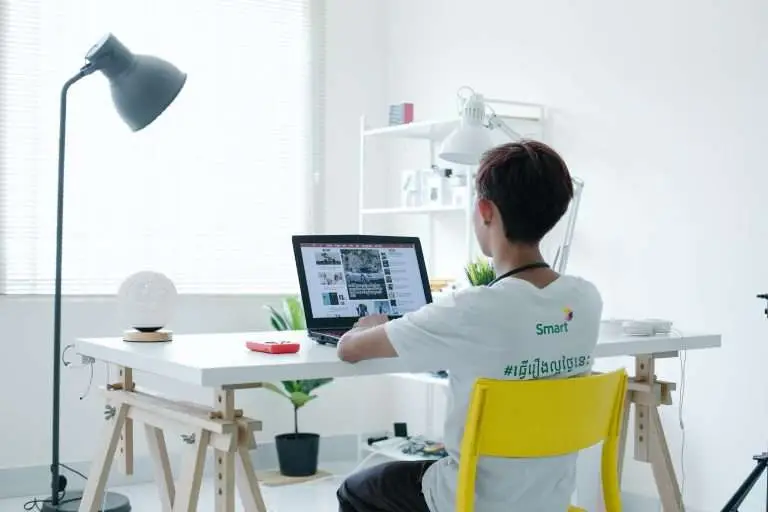THE 5 BEST WAYS TO FIX POSTURE WORKING FROM HOME
Is your posture slowly crawling off into a corner and starting to stink? Working from home can be devastating for your posture. But don’t worry! There are plenty of ways to fix posture working from home and keep you on top form. And none of them involve dragging yourself down to the gym!
Table of Contents
WHAT’S THE PROBLEM? WHY IS WORKING FROM HOME SO BAD FOR YOUR POSTURE?
At your office, people had (hopefully!) thought about the design of your desk and workstation. They should have been set up at the right height for you, and you’re there with a monitor, keyboard, mouse, and office chair. But now we’re at home, many of us are working on dining tables, dressers and chests of drawers, kitchen worktops, beds, sofas and even ironing boards!
Nobody has visited you at home to help setup your work environment, and you’d probably rather they didn’t drop round to your house anyway! The best way to fix posture working from home is to do it yourself, with a little online help from the posture experts.
Whether you’re going to be working at home permanently, temporarily, or a mixture of both, looking after your posture is the number one thing that’s going to make a difference to how you look and feel at the end of the day.
Maybe you’ll invest in a standing desk? It’s not as simple as just sitting or standing, both of those aren’t good for you for long periods of time. So, you’ll need to invest in an adjustable one. Which means figuring out how to adjust it best for you, because everyone’s a different shape and size.
One of the biggest problems for posture with working from home is that, actually, many people move *less* than they did at work – because there aren’t other people to walk over to, no coffee chats, trips to the canteen, or the sultry lure of you-know-who in accounts to go and ogle at (just guessing, I never saw anyone like that myself…)
And if you just have a laptop for working at home, and you don’t have, or don’t use, an external monitor, keyboard and mouse, then you’re at a real postural disadvantage. This is something that needs sorting sooner rather than later! You can get some really cool all-in-one laptop ergo kits. Or for free, just making your own, and adding a keyboard and mouse will transform your laptop from a death-trap into a pleasure to work with. Well, it depends what work you do…
Luckily, there are lots of solutions to help, ranging from simple exercises and stretches all the way through to electric sit-stand desks and even virtual environments. Let’s dive in and take a look:
WHAT’S THE SOLUTION? HOW TO FIX YOUR POSTURE WORKING FROM HOME

The gorgeous, tanned muscly people on Youtube and Instagram can help you to be more like them and do their one quick fix. You can go for that, but me, I’m not up to all that effort and contortion and time in the gym. But there’s no denying, a little exercise can go a long way.
The chiropractors, osteopaths, massage therapists and physio’s, they can help you find your muscular imbalances, and many of them are now available to consult online, which is handy if you don’t want to leave the house but do want to fix your posture working from home.
Then there’s the yoga, taichi, barre, pilates, crossfit and the other exercise pro’s who’ll help you to stretch, or strengthen, or release, or bend, or stand on your head. I’m not sure how that last one helps! But they’re there on Youtube and Zoom and ready to help.
Mindfulness and Alexander Technique practitioners want you to be more aware of yourself so you’re not holding bad posture in the first place – online sessions are a good option, ooh and great for stress too!
A million online shops (and one global super-shop, you know the one) want you to wear their corsets, buy their apps, or plug into their wearables. There are literally thousands of products out there all offering to help. But which ones are right for you?
Maybe your boss or your partner just wants you to use your chair right and just remember to sit up straight, but that’s easier said than done.
There are just sooooo many ways to improve your posture, so which one’s right for you?
Our mission is to help you find the right ways: The ones that are right for you, not just some generic desk-worker. So you don’t end up broken like I once did. And if you already are broken, then I want to help you climb out of that hole! Some of you *will* want to throw iron weights around or bend like a reed.
Some of you will want to spend your way to better posture, with apps and toys and clothes. Some of you will just want fixing by someone else, and some of you will want to fix yourselves by getting in tune with your body and holding yourself better (that’s what I teach, by the way). What fits for you will not fit for the next person.
And you really don’t have to be beautiful, slim, young and strong to have fabulous, pain-free posture. It just helps. The real answer to the question “how do I fix my posture”, well, that all down to you!
As you’re here, you’ve probably already been looking for ways to fix your posture problem. You’ll notice that a lot of posture solutions declare that they are the “best way to fix your posture”. And some even claim to be the “only way to fix your posture!”
Well, like all things in life, if only it were that simple!
After 15 years in the posture business, I’ve pulled together the different ways that do work, for you.
And the best way?
It’s a combination of them all. Yes, like they say, variety is the spice of life. And a combined approach to sorting your posture works best!
Over the years I’ve pulled together the best ways to fix posture working from home. Let’s look at these now.
1. POSTURE EXERCISES TO FIX POSTURE WORKING AT HOME

Posture exercises are just one of a number of ways to improve your posture. They include Yoga, Tai Chi, Pilates, Alexander Technique, Barre, Cross Fit, stretching, and good-old plain-and-simple lifting weights.
Yoga classes work by increasing your flexibility. This means you’re less likely to have unduly tense muscles or tight fascia pulling you out of shape.
Tai Chi is an ancient practice that encourages the flow of chi, or energy, within the body to enable flowing movement.
Pilates is a popular strengthening tool. It’s a series of exercises that focus on strengthening the body. Pilates has a particular focus on core strength.
The Alexander Technique is a mind-body principle that could best be described as practical mindfulness. An Alexander Technique teacher will spend time developing your skills of self-awareness, body awareness, and how you respond to stuff. This is because the goal is to move freely and effortlessly, reducing your tendency to tense up to get stuff done.
Barre classes combine ballet, yoga, strength training and Pilates in order to provide a total body workout. The workout aims for strengthening and releasing tension. They are relatively new, and becoming more popular.
Cross Fit builds strength and conditioning with class-based functional movement exercises.
Stretching frees up tense muscles and fascia to increase ranges of movement. Much like yoga. We love a good stretch. So do cats. We should be more like them. Just not as demanding.
And weightlifting helps to build muscles and strength. As a result, it’s easier to keep good posture going and life is less tiring. It’s important to weightlift with good form though. Because weightlifting with bad form can lead to injury and bad posture.
2. POSTURE THERAPIES AND EXPERTS

Posture therapies and treatments range from the purely physical through to the purely mental.
When you first think about therapies for posture, you probably think of Physical Therapy, Chiropractic, Osteopathy, and massage.
There are also therapies like Alexander Technique, or Mindfulness, that can change how self-aware you are, and so improve your posture.
Some people specialise in posture, like me. Check out my posture training courses and posture coaching.
You can also find people who’ve trained in Egoscue, in Gokhale method, or youtube and other online course coaches.
Which posture therapies and treatments you choose will result as a factor of many things – price, frequency, location and availability, and recommendations from friends and family.
But what’s the difference between Physical Therapy and Osteopathy? How about the difference between Chiropractic and Osteopathy? And where does massage differ from Physical therapy? We take a look at the differences. And more importantly, we check out how each therapy works as a posture therapy.
Each one of these has a different definition of posture. What exactly is it, that they describe as being ‘good posture’? Does their treatment work online for you too?
3. BODY AWARENESS AND BODY MINDFULNESS POSTURE SKILLS

Awareness of your posture makes a massive difference to how you manage your posture. And yet it’s so easy to forget.
You might start your day thinking “Right! I’m going to keep great posture today!” and within 5 minutes you’ve completely forgotten, until you see yourself in a mirror, or you start to hurt.
So it’s not just a case of deciding to increase your postural awareness and then letting things take their course.
Thankfully, there are lot’s of ways to increase your postural awareness.
Exercises like Yoga and Pilates are good for building postural awareness, as are martial arts. In particular, Aikido is great for being calm and well-postured in the heart of the storm.
There are also more ‘thinky’ types of things you can try. Feldenkrais and Alexander Technique are both great for increasing your ability to be self-aware as you go about your day. And mindfulness is useful as a way of keeping aware of yourself and your environment too.
If all that sounds a bit much, you can pick certain daily activities, like making a drink or cleaning your teeth, making sure you have good posture while you do them. Porch have an article on 6 daily tasks that can affect your posture, from doing the dishes to watching TV – there are so many activities you can give more attention.
I call these little activities ‘pings’ because they act like little pings of awareness through your day. As you build them up, it gets easier and easier to remember, which is a great way to fix posture working from home.
Can you think of a way to increase your own postural awareness? Most people say using sticky-notes on your monitor, mirrors, or fridge. But the reality is that you soon get ‘sticky-note-blind’ – the brain stops seeing them because it’s become used to it. So it’s a good idea to take a more structured training, like this posture mindfulness course.
4. POSTURE DEVICES, APPS AND WEARABLES

Can posture devices apps and wearables help you fix bad posture?
They range from simple corsets, through break timers, all the way to posture monitoring devices that connect to your smartphone and relay real-time or regular updates to you.
The most popular posture devices are also the easiest to source. That’s posture correctors. Coming in all ranges of size and stiffness, they simply aim to pull you back into shape. They also make it feel awkward to have bad posture, so they can be a handy reminder when your posture is bad.
But some specialists claim that, while they are a good short-term posture aid, they can be a problem in the long term, as they take away some of the effort muscles require to stay strong. This leaves the risk of weakening, meaning you could end up with worse posture than when you started! So, these devices are usually recommended to be used in conjunction with other posture fixes like the ones we’re looking at here.
Posture devices apps and wearables are definitely becoming more capable and more popular, and can be anything from a basic break timer, to letting you know you’re holding your smartphone at a bad angle, to monitoring your posture and providing feedback through an app.
When you match a specific app with its own wearable, that’s when things really pick up. On-body units that talk directly to your smartphone app are on the rise.
Who knows where this technology will go next!
5. ERGONOMICS AND DESK SETUP FOR YOUR POSTURE

You may have noticed that all the above posture fixes are all about you. Some are very physical, like strength training, and some are very mental, like Alexander Technique. Even the posture apps and wearables are working on ‘you’.
But there’s one last category of help, one that’s completely outside of you. But it’s often the quickest win, and certainly the easiest to apply if you’re willing to improvise or to spend.
And that, my friends, is ergonomics.
All that time that you’re spent hunched badly over the kitchen table, or hurting your arms and wrists trying to type at a bad height or craning your neck to look into a poorly-positioned monitor. All that time! It takes its toll.
Deciding “I’ll just trot out his one email then I’ll take a movement break” and then finding yourself still there two hours later?
Sat on that Zoom call thinking “ooh my poor derriere aches, and my lower back, when will this end?”
These are all easily adjusted using the right setup and some simple no-cost, low-cost, or costly solutions. And they’re all worth it. Each. And. Every. One.
Q: Can you tell what’s wrong with this setup?

A: Contact stress on the wrist is likely to cause pain or injury. Dog is too cute 13/10.
Q: And what about this setup?

A: Same problem, this time the arms are resting on the hard solid edge of the desk, a recipe for pain. Also, the hips are below the height of the knees, and the leg is pressed against the hard edge of the desk. What’s more, the neck is having to pull forward to see the screen. Not good!
Q: And finally, what about this one?



